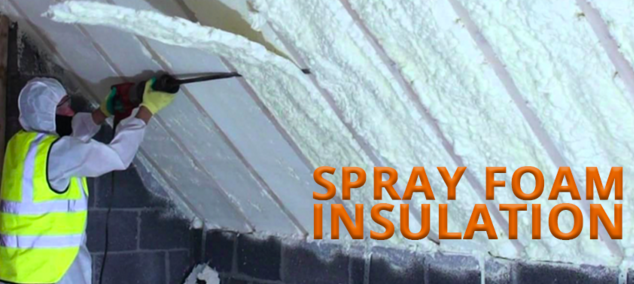Sponsored Post – from Native
When building an energy efficient, net-zero home in Texas, it is vital to eliminate or greatly reduce energy loss with a high performance thermal envelope. Spray foam insulation, an alternative to traditional building insulation such as fiberglass, saves on energy costs and greatly lowers utility bills.
Studies by the US Department of Energy show that 40% of a home’s energy is lost as the result of air infiltration through walls, windows and doorways. Buildings treated with spray foam insulation typically insulate as much as 50% better than traditional insulation products.
Here in central Texas, we live in a Hot-Humid climate zone, which requires mechanical ventilation to remove humidity and maintain temperature for comfort. 80-90% of heat gain occurs at the roof. Spray foam insulation prevents heat from entering the thermal envelope.
Thermal Resistance (R-value)
 R-value is the term given to thermal resistance to heat flow. The higher the R-value of an insulation product, the more effective the insulation properties. R-value increases with thickness of insulating material, but *note that air sealing capabilities and air in/exfiltration is not considered when measuring thermal resistance. Polyurethane is a closed-cell foam insulation material that contains a low-conductivity gas in its cells. As a result of the high thermal resistance of the gas, spray polyurethane insulation typically has an R-value around R-5 to R-6 per inch. In comparison, blown fiberglass typically has an R-Value of only R-2 to R-4 per inch.
R-value is the term given to thermal resistance to heat flow. The higher the R-value of an insulation product, the more effective the insulation properties. R-value increases with thickness of insulating material, but *note that air sealing capabilities and air in/exfiltration is not considered when measuring thermal resistance. Polyurethane is a closed-cell foam insulation material that contains a low-conductivity gas in its cells. As a result of the high thermal resistance of the gas, spray polyurethane insulation typically has an R-value around R-5 to R-6 per inch. In comparison, blown fiberglass typically has an R-Value of only R-2 to R-4 per inch.
Spray foam insulation’s most important attribute is the ability to air seal creating a custom airtight envelope within the building structure. The added benefit to air sealing is the ability to block convective heat transfer from interior to exterior during heating months and vice versa during cooling months, as the heat cannot escape through gaps in the buildings envelope without the aid of air movement from infiltration as a means of transport.
Spray Foam insulation blocks all three forms of heat transfer:
Conductive heat transfer – The flow of thermal energy through a substance from a higher to a lower temperature region.
Radiant heat transfer – The process by which heat energy in the form of light (usually IR unless the substrate is hot enough to glow in the visible range) is emitted more strongly by warm surfaces and absorbed by other materials especially those of low IR reflectivity (think matte black finish).
Convective heat transfer – Heat which is created elsewhere that is transported by means of a fluid, such as water or in our case air.
How it Works
 Spray foam insulation has a two part spray process, starting with two 55 gallon drums – one with urethane material, and water based blowing agent in the other.
Spray foam insulation has a two part spray process, starting with two 55 gallon drums – one with urethane material, and water based blowing agent in the other.
Two chemicals mix at the spray nozzle and instantly expands to 100X applied thickness, adhering to the sprayed surface, and filling all gaps and voids to make a great air barrier.
Open Cell Foam – R-3.7/inch
- Air barrier, but water vapor permeable
- Primarily used on interior applications against wood to prevent vapor from being trapped against framing.
Closed Cell Foam – R-6/inch
- Air and water vapor barrier
- Primarily used on exterior applications where vapor barrier is needed, ie: crawlspaces
- Approximately 2X cost of open cell foam
Example of Application
Spray Foam Insulation Pros & Cons
The Good
- Excellent air sealing
- Easy retrofit in attic
- Places insulation at roof deck
- puts mechanicals inside conditioned space
- Keeps attic within 8-10° of living space
- Reduces mechanical sizing requirements
- Approximately 25% energy reduction
The Bad
- Contains polyurethane
- Off-gasses VOCs for a couple of days
- When applied to full-fill walls, can result in lots of landfill waste
- More expensive than batt insulation



